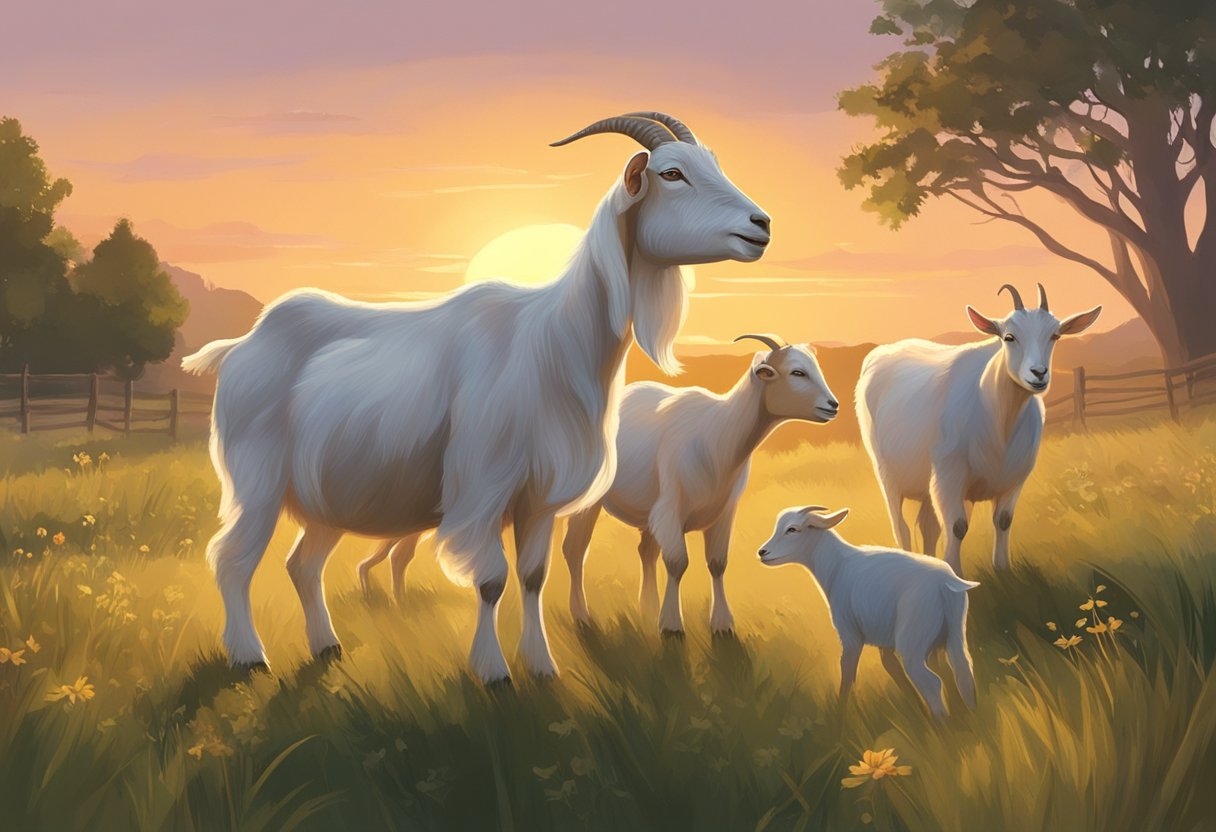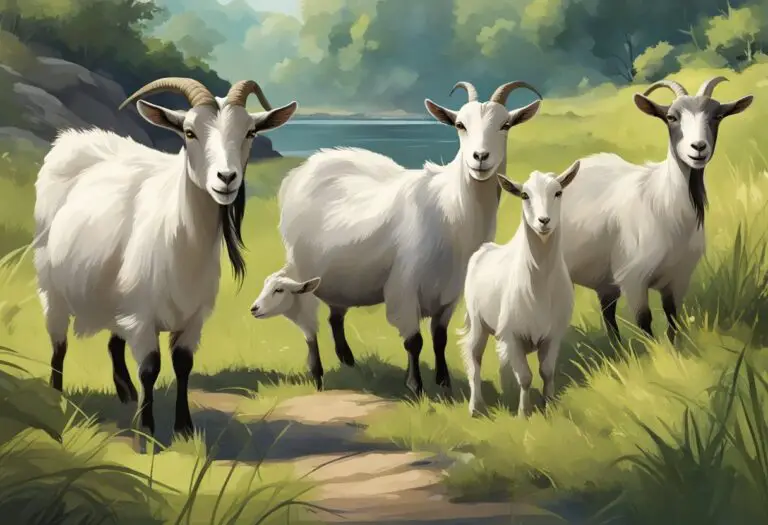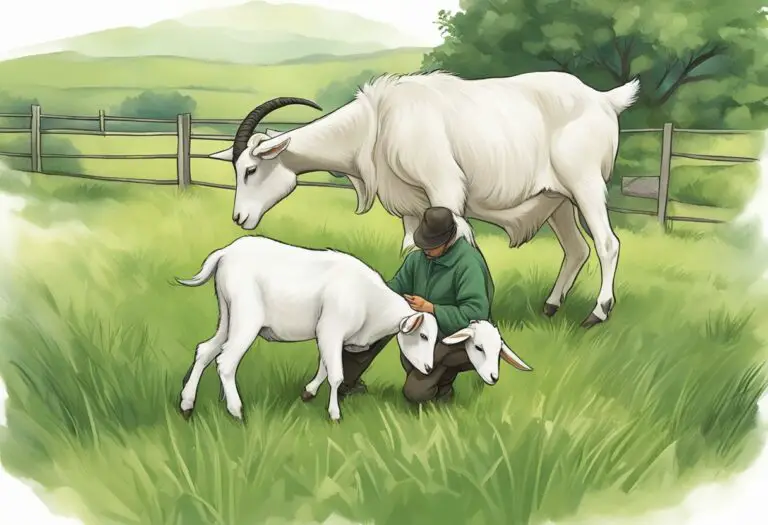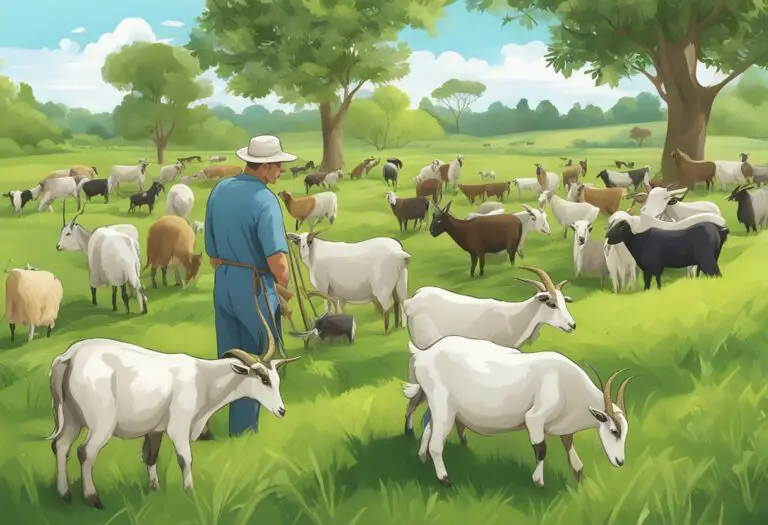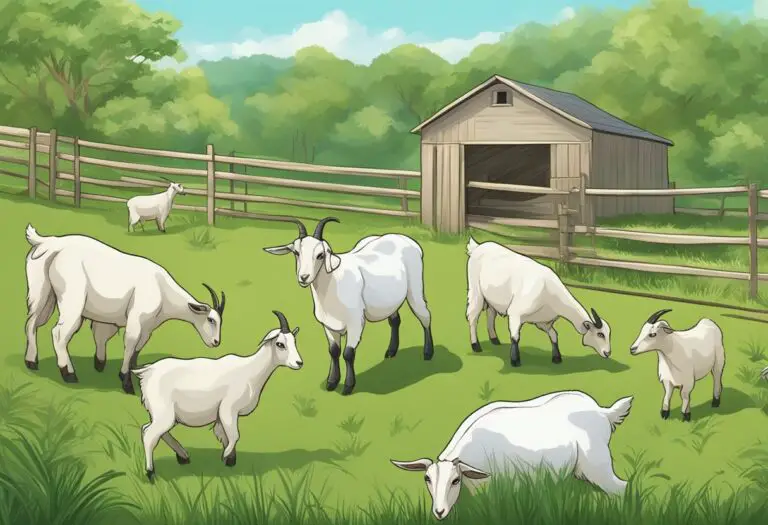What is the Gestation Period for Goats? A Clear and Confident Answer
Goats are a common livestock animal that are raised for their milk, meat, and fiber. As with any animal, understanding their gestation period is crucial for successful breeding and birthing. The gestation period for goats varies depending on the breed, age, and health of the mother goat.
On average, the gestation period for goats is between 145 to 155 days, or roughly five months. However, some breeds may have shorter or longer gestation periods. For example, Nigerian Dwarf goats typically have a gestation period of 145 days, while Boer goats may have a gestation period of up to 155 days. It is important for goat breeders to know the gestation period of their specific breed in order to properly prepare for the birthing process.
Understanding Gestation

Definition of Gestation
Gestation refers to the period of time during which a female animal carries a developing embryo or fetus within her body. It is the time between conception and birth. In goats, gestation is the process by which a fertilized egg grows and develops into a fully formed kid.
Gestation in Mammals
The length of gestation varies among different mammal species. In goats, the gestation period is typically around 150 days, or about 5 months. However, it can range from 145 to 155 days depending on the breed of the goat.
During gestation, the developing kid is completely dependent on the mother for nutrition and protection. The mother’s body undergoes many changes to support the growth and development of the fetus, including an increase in blood volume, changes in hormone levels, and the development of the placenta.
It is important for goat owners to provide their pregnant does with proper nutrition and care during gestation to ensure the health of both the mother and the developing kid. This includes providing a balanced diet, regular veterinary check-ups, and a clean and comfortable living environment.
In conclusion, understanding gestation is crucial for goat owners who want to ensure the health and well-being of their animals. By providing proper care and nutrition during this period, owners can help ensure a successful pregnancy and the birth of healthy kids.
Goat Reproduction

Goats are known for their high fertility rates and short gestation periods. Understanding the breeding cycle of goats and the factors that affect fertility can help farmers to successfully breed their goats and increase their herd size.
Breeding Cycle
The breeding cycle of goats is influenced by the length of daylight. Goats are seasonal breeders and typically breed during the fall and winter months. The onset of breeding season is marked by the presence of a buck in the herd. Bucks will exhibit a variety of courtship behaviors, such as vocalizations, head-butting, and spraying urine on their faces.
Once a doe is in estrus, or heat, she will exhibit signs such as restlessness, frequent urination, and a swollen vulva. During this time, the doe is receptive to the buck and can be bred. The gestation period for goats is approximately 150 days, or five months.
Factors Affecting Fertility
Several factors can affect the fertility of goats. Nutrition plays a crucial role in the reproductive success of goats. A diet that is deficient in nutrients can lead to decreased fertility rates, while a diet that is too high in protein can lead to reproductive issues such as cystic ovaries.
Age is another important factor in goat fertility. Does typically reach sexual maturity at six months of age, but it is recommended to wait until they are at least one year old before breeding them. Bucks can begin breeding at six months of age, but it is recommended to wait until they are 18 months old before breeding them to ensure healthy offspring.
Stress can also impact the fertility of goats. Stressful events such as transportation, changes in environment, and overcrowding can lead to decreased fertility rates. It is important to provide a calm and stable environment for goats to ensure optimal reproductive success.
Gestation Period for Goats

Goats are known for their hardiness and versatility and are often raised for their milk, meat, and fiber. A crucial aspect of goat farming is understanding the gestation period of goats.
Average Duration
The gestation period for goats, on average, is approximately 150 days or five months. However, this can vary slightly depending on the breed, age, and health of the goat. It is essential to keep accurate records of breeding dates to determine the due date accurately.
During the gestation period, it is crucial to provide proper nutrition and care to ensure the health of the doe and her developing kids. This includes a balanced diet, access to clean water, and regular veterinary check-ups.
Breed Variations
While the average gestation period for goats is 150 days, breed variations can occur. For example, Angora goats have a slightly longer gestation period of 155-160 days, while Pygmy goats have a shorter gestation period of 145-153 days.
It is important to note that factors such as the age and health of the doe can also affect the gestation period. Older does may have a shorter gestation period, while younger does may have a longer gestation period.
In conclusion, understanding the gestation period of goats is crucial for successful goat farming. By providing proper nutrition and care and keeping accurate records of breeding dates, farmers can ensure the health of their goats and the successful birth of healthy kids.
Stages of Goat Pregnancy

Goats have a gestation period of about 150 days, or roughly 5 months. During this time, their bodies go through a series of changes as the fetus develops. Understanding the different stages of goat pregnancy can help farmers and breeders ensure the health and well-being of their animals.
Early Stage
The early stage of goat pregnancy lasts from conception to around day 50. During this time, the fertilized egg implants itself in the uterus and begins to develop into an embryo. The goat may not show any visible signs of pregnancy during this stage, but there are some subtle changes that can be observed.
One of the first signs of pregnancy is a decrease in appetite. This is because the goat’s body is diverting energy and resources towards supporting the developing fetus. The goat may also appear more lethargic than usual, and may spend more time resting or lying down.
Mid Stage
The mid stage of goat pregnancy lasts from day 50 to around day 100. By this point, the fetus has developed significantly and is starting to resemble a miniature goat. The goat’s belly will begin to grow noticeably, and the udder may start to swell in preparation for milk production.
During this stage, it is important to ensure that the goat is getting enough nutrition to support the growing fetus. Feeding a high-quality diet that is rich in protein and minerals can help ensure a healthy pregnancy and a strong, healthy kid.
Late Stage
The late stage of goat pregnancy lasts from day 100 until birth. During this time, the fetus is fully developed and is growing rapidly. The goat’s belly will be very large and may hang low, and the udder will be fully developed and may start to produce milk.
As the due date approaches, the goat may become restless and start to paw at the ground or nest in preparation for giving birth. It is important to provide a clean, quiet, and comfortable space for the goat to give birth, and to monitor her closely for any signs of distress or difficulty. With proper care and attention, most goats give birth without any problems and produce healthy, thriving kids.
Care During Gestation

Goats have a gestation period of about 150 days, or approximately 5 months. During this time, it is important to provide them with proper care to ensure the health of both the mother and the developing kids. Here are some important aspects to consider during gestation:
Nutritional Needs
Proper nutrition is crucial during gestation. Pregnant goats require a balanced diet that is high in protein, energy, and minerals. They should have access to good quality hay or pasture, as well as a commercial goat feed that is specifically formulated for pregnant does. It is also important to provide them with clean, fresh water at all times.
Veterinary Care
Regular veterinary check-ups are important during gestation to monitor the health of the mother and the developing kids. It is recommended to have a veterinarian perform an ultrasound to confirm pregnancy and check for any potential issues. Deworming and vaccinations should also be administered as recommended by a veterinarian.
Shelter and Comfort
Goats should have access to a clean, dry, and well-ventilated shelter during gestation. The shelter should be large enough to accommodate the pregnant doe and provide enough space for her to move around comfortably. Soft bedding, such as straw or shavings, should be provided to ensure their comfort. It is also important to keep the shelter clean and free of any sharp or hazardous objects that may harm the mother or the developing kids.
By providing proper care during gestation, goat owners can ensure the health and well-being of their animals and increase the chances of a successful pregnancy and delivery.
Signs of Approaching Parturition

As the gestation period for goats comes to an end, there are a few signs that indicate that parturition is approaching. These signs are important to look out for as they can help ensure that the goat and her offspring receive the care they need during and after birth.
One of the most obvious signs is the enlargement of the udder. As the goat gets closer to giving birth, her udder will become larger and firmer. This is because the udder is preparing to produce milk for the newborn kids.
Another sign is the relaxation and swelling of the vulva. This is a result of hormonal changes in the goat’s body and is a sign that the birth canal is preparing for delivery.
The goat may also begin to separate herself from the herd and show signs of restlessness. She may paw at the ground, lie down and get up frequently, and vocalize more than usual. These behaviors are a sign that she is experiencing discomfort and may be getting ready to give birth.
It is important to monitor the goat closely during this time and provide her with a comfortable and clean place to give birth. By recognizing these signs of approaching parturition, goat owners can ensure that their goats have a safe and successful delivery.
Post-Gestation Care

Postpartum Recovery
After giving birth, a goat needs proper care and attention to ensure a smooth recovery. The first few days after delivery are crucial, and the goat should be kept in a clean and dry area to avoid any infections. The goat’s udder should be checked regularly for any signs of swelling or discomfort, and if necessary, a veterinarian should be consulted.
It is also important to provide the goat with a balanced diet that includes high-quality hay, fresh water, and a mineral supplement. The goat’s appetite may decrease after delivery, but it should gradually increase over the next few days. If the goat is not eating or drinking, a veterinarian should be consulted immediately.
Neonatal Care
Newborn goats, or kids, require special care to ensure their health and well-being. The kids should be kept in a clean and warm area, away from any drafts or extreme temperatures. They should be fed colostrum, the first milk produced by the mother, within the first few hours of birth to provide them with essential nutrients and antibodies.
After the first few days, the kids should be fed milk replacer or goat milk every few hours until they are weaned. It is important to monitor the kids’ weight and growth to ensure they are healthy and thriving. The kids should also be vaccinated and dewormed according to a veterinarian’s recommendations.
In conclusion, proper post-gestation care is essential for the health and well-being of both the mother goat and her kids. By providing the necessary care and attention, farmers can ensure a successful and profitable goat farming operation.

